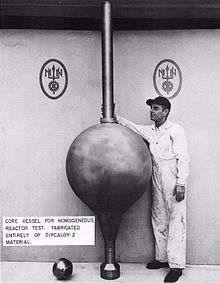
Aqueous homogeneous reactors (AHR) is a two (2) chamber reactor consisting of an interior reactor chamber and an outside cooling and moderating jacket chamber. They are a type of nuclear reactor in which soluble nuclear salts (usually uranium sulfate or uranium nitrate) are dissolved in water. The fuel is mixed with heavy or light water which partially moderates and cools the reactor. The outside layer of the reactor has more water which also partially cools and acts as a moderator. The water can be either heavy water or ordinary (light) water, which slows neutrons and helps facilitate a stable reaction, both of which need to be very pure.
Their self-controlling features and ability to handle very large increases in reactivity make them unique among reactors, and possibly safest. At Santa Susana, California, Atomics International performed a series of tests titled The Kinetic Energy Experiments. In the late 1940s, control rods were loaded on springs and then flung out of the reactor in milliseconds. Reactor power shot up from ~100 watts to over ~1,000,000 watts with no problems observed.
Aqueous homogeneous reactors were sometimes called "water boilers" (not to be confused with boiling water reactors), as the water inside appears to boil, though the bubbling is actually due to the production of hydrogen and oxygen as radiation and fission particles dissociate the water into its constituent gases, a process called radiolysis. AHRs were widely used as research reactors as they are self-controlling, have very high neutron fluxes, and were easy to manage. As of April 2006, only five AHRs were operating according to the Research Reactor database.[1]
Corrosion problems associated with sulfate base solutions limited their application as breeders of uranium-233 fuels from thorium. Current designs use nitric acid base solutions (e.g. uranyl nitrate) eliminating most of these problems in stainless steels.